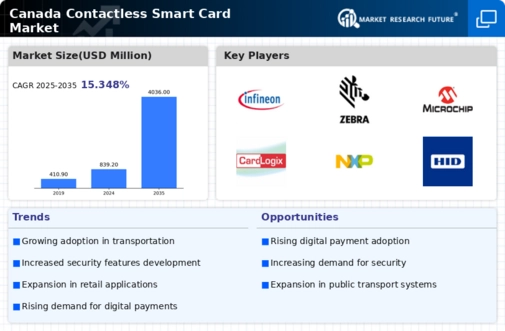Increased Focus on Health and Hygiene
The heightened awareness of health and hygiene among consumers is driving the contactless smart-card market in Canada. As individuals seek to minimize physical contact in public spaces, contactless payment methods are becoming increasingly appealing. Surveys indicate that approximately 70% of Canadians prefer contactless transactions to reduce the risk of germ transmission. This shift in consumer preference is prompting businesses across various sectors, including retail and hospitality, to adopt contactless smart card solutions. The contactless smart-card market is likely to see accelerated growth as more establishments implement these technologies to cater to health-conscious consumers. Additionally, this trend may lead to innovations in contactless card design and functionality, further enhancing user experience.
Growing Demand for Contactless Payments
The contactless smart-card market in Canada is experiencing a notable surge in demand, primarily driven by the increasing preference for contactless payment methods among consumers. As of 2025, approximately 60% of Canadians are utilizing contactless payment options, reflecting a significant shift in consumer behavior. This trend is further supported by the convenience and speed associated with contactless transactions, which are often completed in seconds. Retailers are also adapting to this demand by upgrading their point-of-sale systems to accommodate contactless payments, thereby enhancing customer experience. The contactless smart-card market is likely to benefit from this growing consumer inclination, as more businesses recognize the need to offer seamless payment solutions. Furthermore, the Canadian government has been promoting digital payment methods, which may further bolster the adoption of contactless smart cards across various sectors.
Expansion of Public Transportation Systems
The expansion of public transportation systems in Canada is significantly influencing the contactless smart-card market. Many cities are implementing contactless smart cards for fare payments, which streamlines the boarding process and enhances user convenience. As of 2025, cities like Toronto and Vancouver have reported a 30% increase in the use of contactless payment methods for public transit. This trend not only improves operational efficiency but also encourages more individuals to utilize public transportation. The contactless smart-card market is poised to benefit from this expansion, as municipalities invest in infrastructure that supports contactless technology. Furthermore, partnerships between transit authorities and smart card providers are likely to emerge, fostering innovation and enhancing service delivery.
Technological Advancements in Card Security
Technological innovations are playing a crucial role in shaping the contactless smart-card market in Canada. The introduction of advanced security features, such as EMV (Europay, MasterCard, and Visa) technology, has significantly enhanced the security of contactless transactions. As of 2025, it is estimated that over 80% of contactless cards in Canada are equipped with EMV technology, which helps mitigate fraud risks. Additionally, biometric authentication methods are being integrated into smart cards, providing an extra layer of security. This focus on security is essential for building consumer trust in contactless payment systems. The contactless smart-card market is likely to see continued growth as these technological advancements are adopted, ensuring that both consumers and businesses feel secure in their transactions.
Government Initiatives Supporting Digital Payments
Government initiatives aimed at promoting digital payments are significantly impacting the contactless smart-card market in Canada. Various programs and policies are being introduced to encourage the adoption of digital payment solutions, including contactless smart cards. As of 2025, the Canadian government has allocated funding to support the development of digital payment infrastructure, which is expected to enhance accessibility and convenience for consumers. This proactive approach is likely to stimulate growth in the contactless smart-card market, as more businesses and consumers embrace digital payment methods. Furthermore, educational campaigns aimed at informing the public about the benefits of contactless payments may further drive adoption rates, creating a more favorable environment for market expansion.






















Leave a Comment